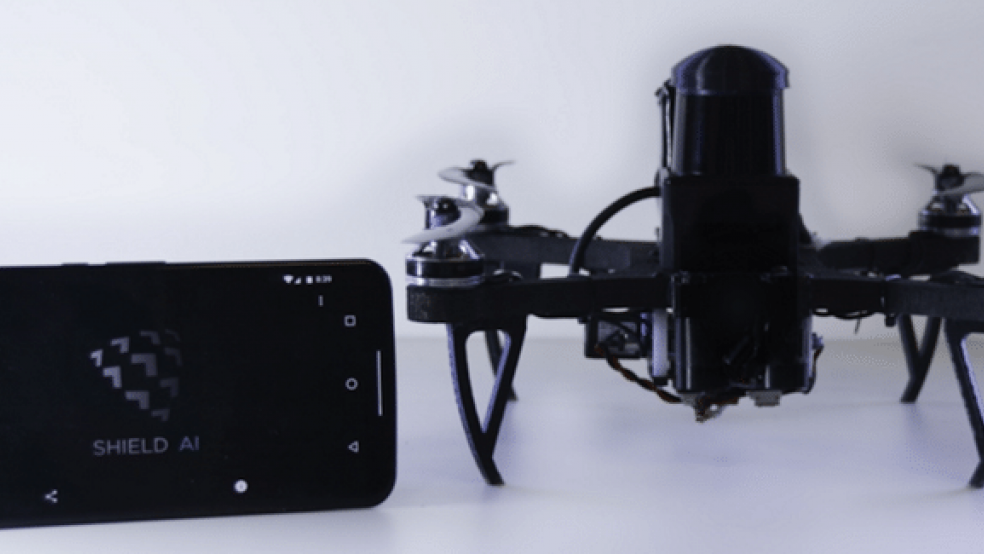In the movie Eye in the Sky, a joint U.S.-British military operation puts an insect-sized drone inside the house of a terrorist. The live feed allows the onlookers in Washington, London, and elsewhere to verify the target and collect data that would be inaccessible from a sensor ball mounted on a Predator flying overhead. aSan Diego company called Shield AI is bringing that vision to life.
Taking off with the push of a button, the Shield AI drone flies into a building and autonomously maps its interior using cameras, lasers, and inertial and ultrasonic sensors. Unlike your average off-the-shelf drone, it requires no human piloting and doesn’t need GPS.
Related: Game of Drones: The Air Force Ramps Up Video Game Warfare
On Sept. 1, the company received $1 million from the Naval Special Warfare Command and the Defense Innovation Unit Experimental, or DIUX, the Pentagon’s Silicon Valley outreach office, for a nine-month prototype project.
Shield AI’s creation is not the only microdrone on the battlefield. Norway-based Prox Dynamics makes a bug-sized reconnaissance drone called the PD 100 Black Hornet, which British special operators have used on the battlefields of Afghanistan since 2011. U.S. special operations forces and U.S. Marines have also conducted tests with it. At a Defense One event in March, Prox Dynamics demonstrated a new version of their drone that could function without GPS.
But only the Shield AI microdrone can fly without a human.
“Our drone can operate completely autonomously (no remote pilot) inside dense urban environments and GPS-denied areas (inside buildings, tunnels, beneath heavy tree coverage),” Shield AI’s Brandon Tseng said. “Most commercial-off-the-shelf drones say ‘autonomous flight’ but what they means is they can follow GPS way points. If you launch our drone outside of a building, it will fly inside without GPS, map the building, and multi-cast HD video of what’s inside to any number of users…It is the AI that makes it more suitable for all ground operations. Infantry and special operations forces need to have situational awareness at all times, and they lose it if they’re trying to pilot a drone inside. Our AI removes the requirement for a remote pilot.”
Related: The Pentagon Is Developing Disappearing Drones
The push for drones that are GPS-independent says as much about bigger computer intelligence coming in ever-smaller packages as it does about the strategic vulnerability in relying too much on GPS. In 2014, the Defense Advanced Research Projects Agency, or DARPA, put out a request for new algorithms to help small drones navigate the same way that birds do — in other words, without receiving a spoofable signal from an aging satellite.
“Goshawks, for example, can fly very fast through a dense forest without smacking into a tree. Many insects, too, can dart and hover with incredible speed and precision,” program manager Mark Micire noted in the announcement.
The following year, the Army issued a call to “expand the capabilities of GPS Denied (GD) autonomous unmanned systems sensing and collaborating architecture and related components.”
But where nature soars, humankind can but crawl. Birds and insects come out of the egg with onboard visual sensors fully integrated into complex processors that exemplify size, weight, and power efficiency. (That is: Birds have eyes and brains.)
In this 2014 paper, a group of researchers, primarily from NASA, explain why building those same smarts into a micro drone is so hard. The human-designed platforms of 2016 can host only a small camera, computer, and battery. That puts extra pressure on the software – and the algorithms behind that software —to turn that sensor data into autonomous flying, landing, etc. (The paper also introduces the world’s smallest autonomous quadcopter drone that can fly on its own. It weighs in at less than 500g, or half the weight of the Shield AI drone.)
The good news is that the same market forces that are bringing better cameras and more processing to smartphones will also make micro drones smarter as well.
“As recent developments in multi-core smart-phone processors are driven by the same size, weight, and power constraints, micro aerial vehicles (MAVs) can directly benefit from new products in this area that provide more computational resources at lower power budgets and low weight, enabling miniaturization of aerial platforms that are able to perform navigation tasks fully autonomously,” they write.
This article originally appeared on DefenseOne. Read more from DefenseOne:
The US Has Its First Cybersecurity Director
North Korea Is Not Afraid of the International Community
How Will Terrorists Use the Internet of Things? The Justice Department Is Trying to Figure That Out

